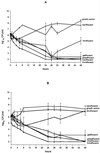Activities of newer fluoroquinolones against ciprofloxacin-resistant Streptococcus pneumoniae
- PMID: 11353608
- PMCID: PMC90528
- DOI: 10.1128/AAC.45.6.1654-1659.2001
Activities of newer fluoroquinolones against ciprofloxacin-resistant Streptococcus pneumoniae
Abstract
The incidence of ciprofloxacin resistance in Streptococcus pneumoniae is low but steadily increasing, which raises concerns regarding the clinical impact of potential cross-resistance with newer fluoroquinolones. To investigate this problem, we utilized an in vitro pharmacodynamic model and compared the activities of gatifloxacin, grepafloxacin, levofloxacin, moxifloxacin, and trovafloxacin to that of ciprofloxacin against two laboratory-derived, ciprofloxacin-resistant derivatives of S. pneumoniae (strains R919 and R921). Ciprofloxacin resistance in these strains involved the activity of a multidrug efflux pump and possibly, for R919, a mutation resulting in an amino acid substitution in GyrA. Gatifloxacin, grepafloxacin, levofloxacin, moxifloxacin, and trovafloxacin achieved 99.9% killing of both R919 and R921 in < or =28 h. With respect to levofloxacin, significant regrowth of both mutants was observed at 48 h (P < 0.05). For gatifloxacin, grepafloxacin, moxifloxacin, and trovafloxacin, regrowth was minimal at 48 h, with each maintaining 99.9% killing against both mutants. No killing of either R919 or R921 was observed with exposure to ciprofloxacin. During model experiments, resistance to gatifloxacin, grepafloxacin, moxifloxacin, and trovafloxacin did not develop but the MICs of ciprofloxacin and levofloxacin increased 1 to 2 dilutions for both R919 and R921. Although specific area under the concentration-time curve from 0 to 24 h (AUC(0--24))/MIC and maximum concentration of drug in serum (C(max))/MIC ratios have not been defined for the fluoroquinolones with respect to gram-positive organisms, our study revealed that significant regrowth and/or resistance was associated with AUC(0-24)/MIC ratios of < or =31.7 and C(max)/MIC ratios of < or =3.1. It is evident that the newer fluoroquinolones tested possess improved activity against S. pneumoniae, including strains for which ciprofloxacin MICs were elevated.
Figures
Similar articles
-
Comparative bactericidal activities of ciprofloxacin, clinafloxacin, grepafloxacin, levofloxacin, moxifloxacin, and trovafloxacin against Streptococcus pneumoniae in a dynamic in vitro model.Antimicrob Agents Chemother. 2001 Mar;45(3):673-8. doi: 10.1128/AAC.45.3.673-678.2001. Antimicrob Agents Chemother. 2001. PMID: 11181341 Free PMC article.
-
Pharmacodynamic activity of fluoroquinolones against ciprofloxacin-resistant Streptococcus pneumoniae.J Antimicrob Chemother. 2002 May;49(5):807-12. doi: 10.1093/jac/dkf022. J Antimicrob Chemother. 2002. PMID: 12003975
-
Mutant prevention concentrations for single-step fluoroquinolone-resistant mutants of wild-type, efflux-positive, or ParC or GyrA mutation-containing Streptococcus pneumoniae isolates.Antimicrob Agents Chemother. 2004 Oct;48(10):3954-8. doi: 10.1128/AAC.48.10.3954-3958.2004. Antimicrob Agents Chemother. 2004. PMID: 15388458 Free PMC article.
-
A critical review of the fluoroquinolones: focus on respiratory infections.Drugs. 2002;62(1):13-59. doi: 10.2165/00003495-200262010-00002. Drugs. 2002. PMID: 11790155 Review.
-
[Pharmacodynamic and pharmacokinetic evaluation of respiratory fluoroquinolones. Guideline to selection of the most appropriate fluoroquinolone].Rev Esp Quimioter. 2012 Dec;25(4):245-51. Rev Esp Quimioter. 2012. PMID: 23303254 Review. Spanish.
Cited by
-
Bacterial Etiology and Antibiotic Resistance Profile of Community-Acquired Urinary Tract Infections in a Cameroonian City.Int J Microbiol. 2016;2016:3240268. doi: 10.1155/2016/3240268. Epub 2016 Sep 7. Int J Microbiol. 2016. PMID: 27667998 Free PMC article.
-
Moxifloxacin: a review of its use in the management of bacterial infections.Drugs. 2004;64(20):2347-77. doi: 10.2165/00003495-200464200-00006. Drugs. 2004. PMID: 15456331 Review.
-
Fluoroquinolone-resistant Streptococcus pneumoniae strains occur frequently in elderly patients in Japan.Antimicrob Agents Chemother. 2002 Oct;46(10):3311-5. doi: 10.1128/AAC.46.10.3311-3315.2002. Antimicrob Agents Chemother. 2002. PMID: 12234869 Free PMC article.
-
Susceptibilities of Campylobacter jejuni isolates from Germany to ciprofloxacin, moxifloxacin, erythromycin, clindamycin, and tetracycline.Antimicrob Agents Chemother. 2003 Jul;47(7):2358-61. doi: 10.1128/AAC.47.7.2358-2361.2003. Antimicrob Agents Chemother. 2003. PMID: 12821499 Free PMC article.
-
Activities of mutant prevention concentration-targeted moxifloxacin and levofloxacin against Streptococcus pneumoniae in an in vitro pharmacodynamic model.Antimicrob Agents Chemother. 2003 Aug;47(8):2606-14. doi: 10.1128/AAC.47.8.2606-2614.2003. Antimicrob Agents Chemother. 2003. PMID: 12878526 Free PMC article.
References
-
- Andes D R, Craig W A. Pharmacodynamics of fluoroquinolones in experimental models of endocarditis. Clin Infect Dis. 1998;27:47–50. - PubMed
-
- Appelbaum P C. Antimicrobial resistance in Streptococcus pneumonia: an overview. Clin Infect Dis. 1992;15:77–83. - PubMed
-
- Barry A L, Brown S D, Fuchs P C. Fluoroquinolone resistance among recent clinical isolates of Streptococcus pneumoniae. J Antimicrob Chemother. 1999;43:428–429. - PubMed
-
- Bartlett J G, Breiman R F, Mandell L A, File T M., Jr Community-acquired pneumonia in adults: guidelines for management. Clin Infect Dis. 1998;26:811–838. - PubMed
Publication types
MeSH terms
Substances
LinkOut - more resources
Full Text Sources
Molecular Biology Databases


